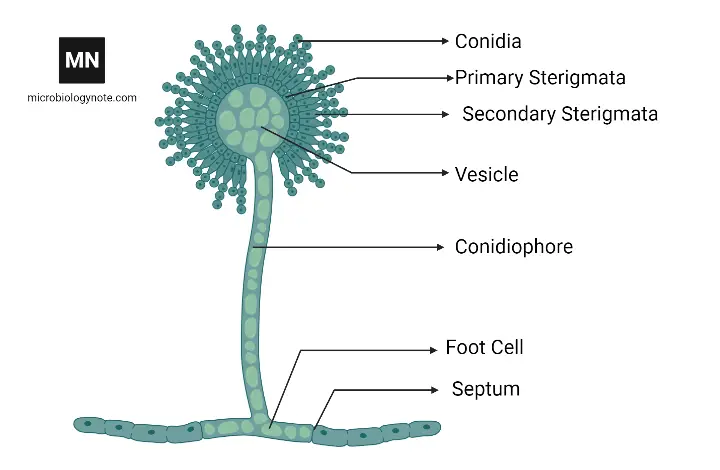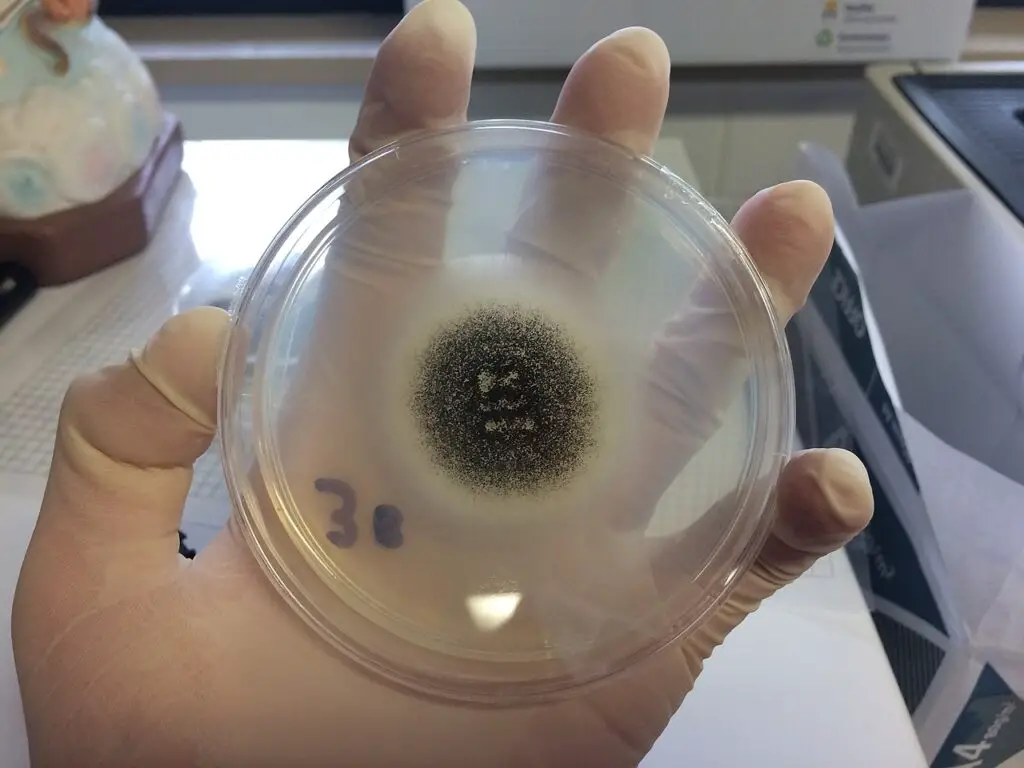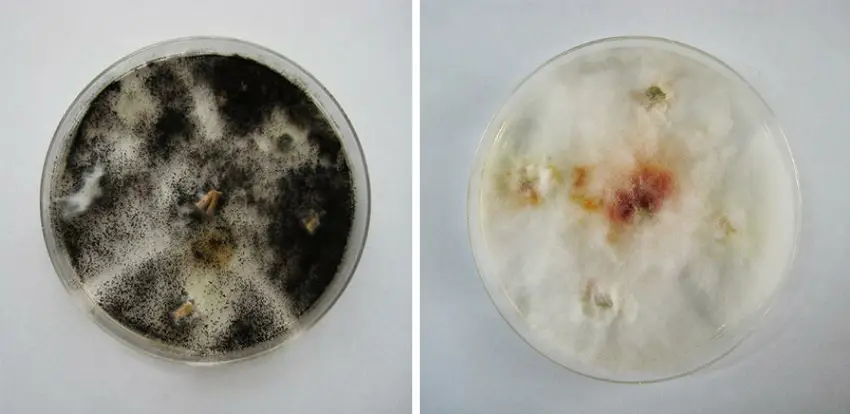Table of Contents
| Kingdom: | Fungi |
| Division: | Ascomycota |
| Class: | Eurotiomycetes |
| Order: | Eurotiales |
| Family: | Trichocomaceae |
| Genus: | Aspergillus |
| Species: | A. niger |
- Aspergillus niger is a spore belonging to the Aspergillus genus’s Nigri section.Aspergillus is a genus of ubiquitous molds found in soil, water, on vegetation, in feces, on decomposing matter, and in the atmosphere. Species belonging to this genus typically grow rapidly and can sporulate a few days after germination.
- A. niger is indispensable for the production of numerous acids, proteins, and bioactive compounds due to a combination of unique characteristics.
- A. niger’s robust production of secondary metabolites is a result of its extensive metabolic diversity, high production yield, secretion capability, and ability to perform post-translational modifications.
- The ability of A. niger to withstand exceedingly acidic conditions makes it vital to the industrial production of citric acid.
- A. niger is a prevalent dietary contaminant that causes “black mold” on grapes, apricots, onions, and peanuts, among other fruits and vegetables. It is widespread in soil and common in indoor environments, where its black colonies can be confounded with those of Stachybotrys (species of which have also been referred to as “black mold”).
- The US Food and Drug Administration classifies A. niger as Generally Recognized as Safe (GRAS) for use in food production, despite the fact that the microbe is capable of producing compounds that are harmful to human health.
History of Aspergillus niger
Aspergillus niger is a filamentous fungus that belongs to the Aspergillus genus. It is commonly found in soil and decaying plant matter and has been known to humans for centuries. Here is a brief history of Aspergillus niger:
- In 1729, Italian naturalist Pier Antonio Micheli first observed and documented the presence of Aspergillus niger. He described it as a “black, powdery fungus” and named it “niger” which means black in Latin.
- During the 19th century, Aspergillus niger was used in the fermentation industry to produce citric acid. This was discovered by a Belgian chemist named Adolph Strecker in 1838.
- In the early 20th century, Aspergillus niger was also used in the production of gluconic acid and other organic acids.
- In the 1930s, Aspergillus niger was used in the production of the first oral antibiotic, penicillin. The fungus was used to produce the penicillin precursor, penicillic acid.
- Aspergillus niger has also been studied for its potential use in bioremediation. Its ability to degrade a wide range of organic compounds has made it a useful tool in cleaning up contaminated soil and water.
- Today, Aspergillus niger is still used in the food industry to produce citric acid, as well as other enzymes and organic acids. It is also used in the production of biofuels and other industrial processes.
Overall, Aspergillus niger has a long and important history in various industries and fields of study. Its versatility and ability to produce a wide range of compounds has made it a valuable organism for scientific research and industrial applications.
Habitat of Aspergillus niger
- Aspergillus niger is a common filamentous fungus found worldwide in a variety of habitats, including soil, decaying vegetation, and indoor environments.
- It is also commonly found in foods such as fruits, vegetables, and cereals. Aspergillus niger can grow in a wide range of temperatures, from 20°C to 45°C, and can tolerate a pH range of 2 to 9.
- This fungus can adapt to different conditions and survive in harsh environments, including polluted soils and water sources.
- It is also known to grow in association with certain insects, such as beetles and cockroaches. Overall, the versatility of Aspergillus niger allows it to thrive in a wide range of habitats and play important roles in various biological and industrial processes.
Morphology of Aspergillus niger

- As with other filamentous fungi, Aspergillus niger tends to form filaments (hyphae) and therefore resembles the structure of a plant. The conidiophores and spores of A. niger are smooth and colorless when viewed through a microscope.
- A closer inspection reveals that the conidial heads of the organism are globose and dark brown in color, and as A. niger ages, they divide into a number of columns.
- Compared to other varieties, A. niger’s conidial heads (biserite) produce dark or dark brown spores. This trait has only been observed in A. niger and none of the other species.
- The carbon black/dark brown color of the spores and conidia is used to distinguish A. niger from other species within the same genus.
Cultural Characteristics of Aspergillus niger
Aspergillus niger is a filamentous fungus that exhibits specific cultural characteristics when grown on various media. Here are some of the cultural characteristics of Aspergillus niger:
- Colony morphology: Aspergillus niger colonies appear as flat, velvety, and olive-black in color. The colony can grow up to 7 cm in diameter.
- Spore formation: Aspergillus niger produces abundant spores on the surface of the colony, which are initially white or yellow but eventually turn dark brown or black as they mature.
- Growth rate: Aspergillus niger is a fast-growing fungus that can grow on various media within 5-7 days.
- Media preference: A. niger is a strict aerobe, so its growth requires oxygen. Aspergillus niger can grow on a variety of media, including potato dextrose agar (PDA), Sabouraud dextrose agar (SDA), and Czapek Dox agar, lignocellulose agar, and a number of other growth media.
- pH preference: It can withstand a pH range of 1.5 to 9.8.A. niger is xerophilic, which means it can thrive and reproduce in extremely arid conditions. It can also thrive in humid environments, tolerating environments with 90-100 percent relative humidity.
- Temperature preference: The fungus can grow in a variety of environmental conditions, at temperatures spanning from 6 to 47 degrees Celsius. As a mesophile, its optimal temperature range is between 35 and 37 degrees Celsius.


Life Cycle of Aspergillus niger
- Aspergillus niger is a filamentous fungus that reproduces asexually via conidial spore formation. Aspergillus niger’s life cycle begins with the dispersion of conidia onto a suitable substrate where growth conditions are favorable. The optimal temperature range for conidial germination is between 25 and 40 degrees Celsius, and the pH range is between 2 and 9.
- When conidia land on a substrate, they germinate and form vegetative cells. This cell then transforms into hyphal mycelium, which forms aerial hyphae via dichotomous branching. The aerial hyphae develop into conidiophores, which are structures that specialize in the production of conidia.
- At the apex of the conidiophores of Aspergillus niger is an enlarged vesicle that gives rise to primary sterigmata termed phialides. The phialides then produce secondary sterigmata, which are the progenitors of conidial spores. On top of the phialides, the spores form chains and are arranged in columns or multiple rows.
- Aspergillus niger’s conidia are multicellular formations that are essential for the fungus’ propagation and survival. They are resistant to environmental duress and can endure adverse conditions for extended periods of time. The spores can be dispersed by air, water, or other agents and can germinate on suitable substrates when they land.
- Overall, the life cycle of Aspergillus niger consists of a succession of distinct developmental stages, each of which is essential for the fungus’s successful propagation. Aspergillus niger can rapidly adapt to shifting environmental conditions and colonize new habitats due to its ability to reproduce asexually through conidiation. Aspergillus niger is a versatile and adaptable organism with diverse applications in biotechnology and industry as a result of its ability to produce abundant and highly resistant spores.
Pathogenesis of Aspergillus niger
- Plant manifestations: Aspergillus niger is known to cause various types of diseases in both plants and animals, including humans. In plants, Aspergillus niger can cause a black mold of onions and ornamental plants, especially when the conditions are favorable for growth. It infects onion seedlings and can disseminate and become systemic. It can also cause a common postharvest disease of onions, in which the black conidia can be observed between the scales of the bulb. Additionally, Aspergillus niger can cause disease in peanuts and grapes.
- Human and animal disease: While Aspergillus niger is less likely to cause disease in humans and animals compared to other common species of Aspergillus, it can still cause opportunistic invasive pulmonary aspergillosis in individuals with a compromised immune system. This can occur on inhalation of spores from a damaged epithelial lining and respiratory tract system, leading to severe lung disease. Aspergillus niger can also cause aspergillosis in horticultural workers who are frequently exposed to inhalation of peat dust, which is rich in Aspergillus spores.
- In addition, Aspergillus niger is a common cause of otomycosis, a type of fungal ear infection. Otomycosis is associated with temporary impaired hearing, pain, and severe cases that can damage the ear canal and the tympanic membrane. It is typically seen in tropical and subtropical regions and is more prevalent in individuals with a history of exposure to contaminated water, ear canal trauma, or the use of hearing aids.
- Overall, while Aspergillus niger may not be as pathogenic as other species of Aspergillus, it can still cause serious diseases in both plants and animals, including humans. Understanding the pathogenesis of Aspergillus niger is essential for effective disease management and prevention strategies.
Laboratory Diagnosis Methods of Aspergillus niger
Laboratory diagnosis of Aspergillus niger is essential for detecting the presence of the fungus and for determining appropriate treatment strategies. There are several methods for diagnosing Aspergillus niger infections in the laboratory, including:
- Microscopic examination: The presence of Aspergillus niger can be confirmed by microscopic examination of clinical samples. A KOH mount or a fungal stain, such as a lactophenol cotton blue (LPCB) stain, can be used to visualize the fungal elements.
- Culture: Culturing clinical samples on selective media, such as Sabouraud dextrose agar (SDA), can help to isolate and identify Aspergillus niger. Colonies of Aspergillus niger on SDA are usually black, woolly, and velvety in appearance.
- Serological tests: Serological tests, such as the enzyme-linked immunosorbent assay (ELISA), can detect specific antibodies against Aspergillus niger in blood or other bodily fluids.
- DNA-based tests: Polymerase chain reaction (PCR) assays can be used to amplify and detect specific DNA sequences of Aspergillus niger. This method is highly sensitive and specific, and it can be used to detect even small amounts of the fungus.
- Mass spectrometry: Matrix-assisted laser desorption/ionization time-of-flight mass spectrometry (MALDI-TOF MS) can be used to identify Aspergillus niger based on its unique protein profile.
Treatment of Aspergillus niger Infections
The treatment of Aspergillus niger infections depends on the severity of the infection, the site of infection, and the patient’s immune status. In mild cases, the infection may resolve on its own, and treatment may not be necessary. However, in severe cases, treatment is essential, and the following are some of the treatment options for Aspergillus niger infections:
- Antifungal medication: The primary treatment for Aspergillus niger infections is antifungal medication, such as amphotericin B, voriconazole, itraconazole, or posaconazole. These drugs work by inhibiting the growth of the fungus and preventing it from spreading. The choice of medication depends on the severity of the infection and the patient’s immune status.
- Surgery: In some cases, surgery may be necessary to remove infected tissues and reduce the fungal burden. This is particularly true for invasive pulmonary aspergillosis or sinus infections that do not respond to antifungal medication.
- Immunomodulation: In cases where the patient’s immune system is compromised, such as in HIV or transplant patients, immunomodulatory agents may be used in conjunction with antifungal medication to improve the immune response.
- Supportive care: Patients with severe Aspergillus niger infections may require supportive care, such as oxygen therapy, ventilation, or nutritional support, to manage their symptoms and improve their chances of recovery.
Prevention and control of Aspergillus niger
Prevention and control of Aspergillus niger infections involve measures to reduce exposure to the fungus and improve the immune response of the host. The following are some of the preventive measures that can be taken:
- Maintaining good hygiene: Proper sanitation and hygiene practices can prevent the growth and spread of Aspergillus niger. This includes regular cleaning and disinfection of surfaces, equipment, and tools used in food processing, farming, and gardening.
- Proper ventilation: Proper ventilation is essential to prevent the buildup of moisture and humidity, which can promote the growth of Aspergillus niger. This is particularly important in enclosed spaces, such as hospitals, where the risk of infection is higher.
- Using personal protective equipment (PPE): PPE, such as gloves, masks, and respirators, can reduce the risk of exposure to Aspergillus niger spores. This is particularly important for individuals who are at high risk of infection, such as horticultural workers and immunocompromised patients.
- Avoiding contaminated food: To prevent foodborne infections caused by Aspergillus niger, it is essential to avoid eating contaminated food. This includes properly storing and handling food, and avoiding eating foods that are visibly moldy or have an off odor.
- Improving immune response: Patients with weakened immune systems are at higher risk of developing Aspergillus niger infections. To reduce the risk of infection, it is essential to improve the immune response of the host through measures such as vaccination, healthy lifestyle habits, and prompt treatment of underlying medical conditions.
Industrial Uses of Aspergillus niger
Aspergillus niger has a wide range of industrial uses due to its ability to produce a variety of enzymes and organic acids. Some of the industrial uses of Aspergillus niger include:
- Production of citric acid: Aspergillus niger is widely used in the production of citric acid, which is used as a flavoring agent in food and beverages, and as a chelating agent in industrial processes.
- Production of enzymes: Aspergillus niger produces a variety of enzymes, including amylase, cellulase, and protease, which are used in a wide range of industrial processes, such as brewing, baking, and textile production.
- Production of organic acids: Aspergillus niger is also used in the production of other organic acids, such as gluconic acid and fumaric acid, which are used in the food and pharmaceutical industries.
- Production of biofuels: Aspergillus niger is used in the production of biofuels, such as ethanol and biodiesel, through its ability to ferment sugars and produce enzymes that can break down plant material.
- Soil remediation: Aspergillus niger has been used in soil remediation to remove heavy metals and other pollutants from contaminated soil.
FAQ
What is Aspergillus niger?
Aspergillus niger is a filamentous fungus that is commonly found in soil, air, and plant material. It is known for its ability to produce a variety of enzymes and organic acids, which make it useful in a variety of industrial applications.
Is Aspergillus niger harmful to humans?
Aspergillus niger is generally not harmful to humans, although it can cause infections in people with weakened immune systems. It is also a common cause of otomycosis, a type of fungal ear infection.
How is Aspergillus niger diagnosed?
Aspergillus niger can be diagnosed through a variety of laboratory tests, including fungal culture, microscopy, and serological tests.
What are the symptoms of an Aspergillus niger infection?
Symptoms of an Aspergillus niger infection can vary depending on the location of the infection, but may include fever, cough, chest pain, and difficulty breathing.
How is Aspergillus niger treated?
Aspergillus niger infections are typically treated with antifungal medications, such as voriconazole or amphotericin B.
How can Aspergillus niger be prevented?
Aspergillus niger can be prevented by maintaining good hygiene and cleanliness, avoiding exposure to contaminated soil or plant material, and controlling moisture levels in indoor environments.
What are the industrial uses of Aspergillus niger?
Aspergillus niger is used in the production of citric acid, enzymes, organic acids, biofuels, and in soil remediation.
Can Aspergillus niger be used in food production?
Yes, Aspergillus niger is commonly used in food production as a source of citric acid, and as a fermentation agent in the production of certain foods, such as soy sauce and tempeh.
What is the life cycle of Aspergillus niger?
Aspergillus niger reproduces asexually by forming conidial spores. The spores germinate and form a vegetative cell, which develops into hyphal mycelium. The aerial hyphae then grow to form conidiophores, which produce conidial spores.
Where is Aspergillus niger commonly found?
Aspergillus niger is commonly found in soil, air, and plant material, and can also be found in indoor environments with high moisture levels, such as bathrooms and kitchens.
References
- Person AK, Chudgar SM, Norton BL, Tong BC, Stout JE. Aspergillus niger: an unusual cause of invasive pulmonary aspergillosis. J Med Microbiol. 2010 Jul;59(Pt 7):834-838. doi: 10.1099/jmm.0.018309-0. Epub 2010 Mar 18. PMID: 20299503; PMCID: PMC3052473.
- https://www.toppr.com/guides/biology/microorganisms/aspergillus-niger-and-its-uses/
- https://www.inspq.qc.ca/en/moulds/fact-sheets/aspergillus-niger
- https://www.creative-biolabs.com/drug-discovery/therapeutics/aspergillus-niger.htm
- https://www.news-medical.net/life-sciences/What-is-Aspergillus-niger.aspx
- https://en.wikipedia.org/wiki/Aspergillus_niger
- https://www.microscopemaster.com/aspergillus.html
- https://www.researchgate.net/figure/Morphological-characteristics-of-Aspergillus-niger-volumetric-power-input-100-W-m-3_fig1_268427977
- https://www.researchgate.net/publication/340398703_Aspergillus_niger_Spores_Are_Highly_Resistant_to_Space_Radiation
- https://www.ijpsonline.com/articles/fungal-biodiversity-of-a-library-and-cellulolytic-activity-of-some-fungi.html?view=mobile
- https://www.pjms.com.pk/issues/octdec207/article/article9.html
